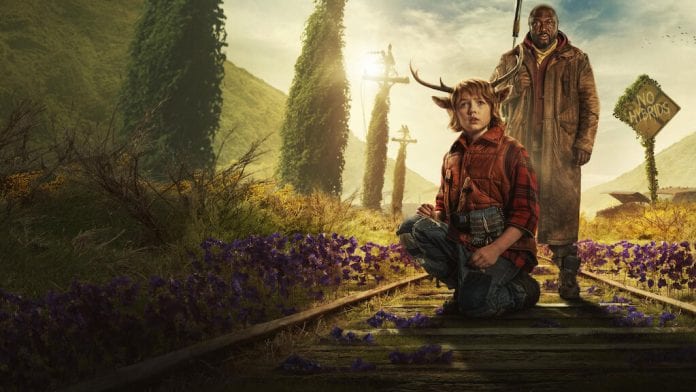Warm, inventive, and detailed, by expanding on familiar situations and relatable characters, Sweet Tooth is one of the best Netflix adaptations to date. Based on a DC comic by Jeff Lemire and developed by Jim Mickle, Sweet Tooth is set ten years after The Great Crumble, which saw the emergence of a deadly virus and human-animal hybrids, the series follows Gus (Christian Convery), a deer hybrid who grew up shielded from the horrors of the outside world and is looking to reunite with his mom.
The most notable accomplishment for this series is its ability to build a world that is both surreal yet entirely plausible. Hybrids and the scale of the pandemic might not be broadly relatable to the viewer, but visual cues like face masks and hand sanitiser are not the only recognisable elements of the fictional pandemic. For instance, the idea of the suburbs having an undercurrent of mob mentality is not new: it has been explored in works that sought to break down the idea of the American Dream. Yet this series looks at it through the lens of a pandemic. One idea that is made clear from the start is that the fear is directed not at the virus, but at the infected. In a scene set in a medical centre, a background sign appears to read “Beware of the Infected”, but when inspected closely, it actually reads “Beware of the Infected Area”. This is an important distinction and a clever detail: a place like the suburbs would never openly display animosity, preferring a more passive aggressive approach. The writers, working with the set designers, succeed in creating an eerily perfect oasis of civility, which hides a much more vicious secret.
Another group featured are a gang of teenagers, the Animal Army, who grew up during The Great Crumble and now dedicate their lives to protecting the hybrids from being captured. This portrayal not only explores Gen Z’s climate change anxieties, but the anger festered in the community. Their leader and founder, Bear (Stefania LaVie Owen), is one of the most compelling characters in the series; partly due to Owen’s performance, and partly due to revelations embedded in later episodes, Bear never comes off as the stereotypical teenage rebel leader. Her kindness towards Gus, paired with her willingness to forgive and grow, set her apart from the more two-dimensional, yet comparable representation seen in The Falcon and the Winter Soldier through the character of Karli Morgenthau. Seeing Bear as a big sister figure makes the loss of her family appear even more tragic than it already is, delivering one of the best emotional moments of the series. Though the group appears as a united front, inner conflicts regarding power and ideology cause the situation to quickly unravel.
Complex, detailed character writing is key in making this strange world so compelling. Dr Aditya Singh (Adeel Akhtar) is a standout, as one of the first doctors to face the reality of The Sick, who settles in the suburbs with his wife Rani (Aliza Vellani), who has the virus. His desperate pursuit for a cure slowly chips away at his humanity, and the viewer witnesses this caring doctor turn to the unthinkable to save his wife. His arc mirrors that of Tommy Jepperd (Nonso Anozie), as they both slowly lose touch with the ideologies they committed to in the past to protect someone they love. However, while Tommy becomes a better man, learning from his fraught past, Dr Singh betrays his morals, gradually turning into a villain. This parallel is emphasised in a brief meeting the two have, where Dr Singh says, “You’ll be surprised what you are capable of when it’s for someone you love.”
The acting is on par with the writing, with great performances delivered all around. The dynamic between Gus, Tommy, and Bear elevates the trope of the “found family” to create a compelling group that viewers grow to love. Convery infuses this project with heart and innocence, sorely needed in a world filled with horrific implications. While Tommy and Bear always carry this knowledge with them, Gus is allowed to explore and learn about this new world. His innocence and wonder are matched by the look of the show, characterized by saturated colours and striking visuals. Of course, there is no way deer antlers and ears on a kid are not going to look fake, yet the creators get around this by adapting the world to the hybrids’ aesthetics. From a horse strolling through the suburbs, to wild animals reclaiming the city, the show is appropriately absurd.
Sweet Tooth leaves the viewer wanting more, and is sure to draw more viewers with its surreal visuals and stellar writing.
Words by Elisabetta Pulcini
Support The Indiependent
We’re trying to raise £200 a month to help cover our operational costs. This includes our ‘Writer of the Month’ awards, where we recognise the amazing work produced by our contributor team. If you’ve enjoyed reading our site, we’d really appreciate it if you could donate to The Indiependent. Whether you can give £1 or £10, you’d be making a huge difference to our small team.
